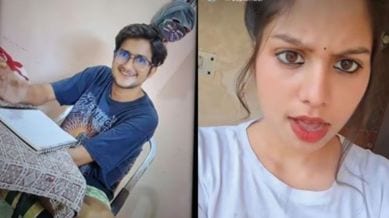Stay updated with the latest - Click here to follow us on Instagram
UPSC aspirant’s murder: Delhi Police plan to use ‘gait analysis’ to bolster case. Here’s what it means
Three people — including the victim's girlfriend — were arrested in connection with the crime

Last month, the charred body of a UPSC aspirant was found in his rented flat in North Delhi’s Timarpur. The Delhi Police initially suspected that the victim, Ram Kesh Meena, 32, died in a fire sparked by a cylinder blast. As the probe unfolded, police found he was murdered allegedly by his girlfriend, her ex-boyfriend and another person.
The trio were arrested two weeks after the crime. The Delhi Police are now planning to carry out a forensic gait analysis to bolster their case.
According to the police, CCTV footage from the night of the incident has emerged as a key piece of evidence. The footage in question had shown three people, with their faces covered, entering the building. After 39 minutes, one person walked out. At 2.57 am, a woman, along with another person, was seen leaving the building. The fire occurred shortly after their departure, police had said.
A senior Delhi Police officer said that though gait analysis has been used multiple times unofficially, it’s rare to present it as evidence in court. “We use it to zero in on a list of suspects. But usually, it’s corroborated with other sets of evidence which are to be presented to the court. This (the UPSC murder case) will be one of the rare times when it would be presented to the court,” the police officer said.
What is gait analysis?
It is the study of human locomotion or movement. In simple terms, it refers to the way a person moves their limbs to walk or run. It is influenced by factors like age and health.
In neuroscience, gait analysis is used to assess and help patients affected by neuromuscular or skeletal disorders including cerebral palsy, spinal cord injuries, and stroke. In podiatry — medical care and treatment of the foot — this technique helps evaluate and diagnose conditions that affect walking and posture.
What is forensic gait analysis? How is it different?
According to an article on the National Library of Medicine website, it is “the assessment and evaluation of gait patterns and features of the person/suspect and comparing these features with the scene of crime evidence for criminal/personal identification”.
It involves experts studying body movements using video recordings. It is particularly useful when video footage of a crime exists, but the suspect’s face is not visible — such as when it is obscured by a cap, mask, or cloth.
However, it cannot be relied upon completely as a standalone method for identification since the uniqueness of a person’s walk is yet to be scientifically proven.
How is the test carried out?
For the analysis, experts compare the gait of the person seen in CCTV footage from the crime scene with a sample video of the suspect’s walk. Using specialised computer software, the two recordings are analysed side by side.
Forensic experts consider various factors during the comparison, such as the movement of the feet and hands, stride length, and the complete gait cycle — from the moment one foot touches the ground to when it touches the ground again after a step.
Before CCTVs were invented, investigating agencies used to rely upon eyewitnesses who might have ‘seen’ someone on the spot with a particular ‘style of walking’.
Has it been used by law-enforcement in India previously?
It has been used in several high-profile cases including the 2021 Saki Naka rape-murder case in Mumbai; it was part of the evidence relied upon by a special court in Mumbai while giving the death sentence to the 44-year-old accused.
In 2024, during its probe into the blast at Rameshwaram Café in Bengaluru, the National Investigation Agency (NIA) decided to use gait analysis to confirm the identity of the man accused of planting the bomb in the popular eatery.
It was also used to establish the identity of the killers of journalist Gauri Lankesh in Bengaluru in 2017.